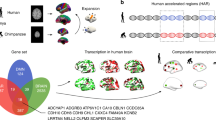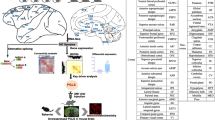Abstract
With the advent of computational genomics, an intensive search is underway for unique biomarkers for Homo sapiens that could be used to differentiate taxa within the Hominoidea, in particular to distinguish Homo from the apes (Pan, Gorilla, Pongo, and Hylobates) and species or subspecies within the genus Homo (H. sapiens, H. heidelbergensis, H. neanderthalensis, H. erectus, and the Denisovans). Here, we suggest that the |-FAM72–SRGAP2-| (family with sequence similarity 72/SLIT-ROBO Rho GTPase activating protein 2) gene pair is a unique molecular biomarker for the genus Homo that could also help to place Australopithecus at its most appropriate place within the phylogenetic tree and may explain the distinctive higher brain cognitive functions of humans.


Similar content being viewed by others
References
Becoming human: Homo sapiens (Accessed 20 May 2016). http://becominghuman.org/
Benayoun BA et al (2014) H3K4me3 breadth is linked to cell identity and transcriptional consistency. Cell 158:673–688. doi:10.1016/j.cell.2014.06.027
Berger LR et al (2015) Homo Naledi, a new species of the genus homo from the Dinaledi chamber. South Africa. Elife 4. doi:10.7554/eLife.09560
Brown P, Maeda T (2009) Liang Bua Homo floresiensis mandibles and mandibular teeth: a contribution to the comparative morphology of a new hominin species. J Hum Evol 57:571–596. doi:10.1016/j.jhevol.2009.06.002
Bruxelles L, Clarke RJ, Maire R, Ortega R, Stratford D (2014) Stratigraphic analysis of the Sterkfontein StW 573 Australopithecus skeleton and implications for its age. J Hum Evol 70:36–48. doi:10.1016/j.jhevol.2014.02.014
Charrier C et al (2012) Inhibition of SRGAP2 function by its human-specific paralogs induces neoteny during spine maturation. Cell 149:923–935. doi:10.1016/j.cell.2012.03.034
Daegling DJ, Patel BA, Jungers WL (2014) Geometric properties and comparative biomechanics of Homo floresiensis mandibles. J Hum Evol 68:36–46. doi:10.1016/j.jhevol.2014.01.001
Dennis MY et al (2012) Evolution of human-specific neural SRGAP2 genes by incomplete segmental duplication. Cell 149:912–922. doi:10.1016/j.cell.2012.03.033
Dewey CN (2011) Positional orthology: putting genomic evolutionary relationships into context. Brief Bioinform 12:401–412. doi:10.1093/bib/bbr040
Dirks PH et al (2015) Geological and taphonomic context for the new hominin species Homo naledi from the Dinaledi Chamber, South Africa. Elife 4. doi:10.7554/eLife.09561
Encyclopedia Britannica: Homo sapiens (Accessed 20 May 2016). http://globalbritannicacom/topic/Homo-sapiens
Encyclopedia of Life: Homo sapiens - Modern Human (Accessed 20 May 2016). http://eolorg/pages/327955/overview
Genomes Project (Accessed 20 May 2016). http://www.1000genomes.org/
Genomes Project C et al (2012) An integrated map of genetic variation from 1,092 human genomes. Nature 491:56–65. doi:10.1038/nature11632
Genomes Project C et al (2015) A global reference for human genetic variation. Nature 526:68–74. doi:10.1038/nature15393
Geschwind DH, Konopka G (2012) Neuroscience: genes and human brain evolution. Nature 486:481–482. doi:10.1038/nature11380
Geschwind DH, Rakic P (2013) Cortical evolution: judge the brain by its cover. Neuron 80:633–647. doi:10.1016/j.neuron.2013.10.045
Granger DE, Gibbon RJ, Kuman K, Clarke RJ, Bruxelles L, Caffee MW (2015) New cosmogenic burial ages for Sterkfontein member 2 Australopithecus and member 5 Oldowan. Nature 522:85–88. doi:10.1038/nature14268
Guo C et al (2008) Ugene, a newly identified protein that is commonly overexpressed in cancer and binds uracil DNA glycosylase. Cancer Res 68:6118–6126. doi:10.1158/0008-5472.CAN-08-1259
Harcourt-Smith WE et al (2015) The foot of Homo naledi. Nat Commun 6:8432. doi:10.1038/ncomms9432
Heese K (2013) The protein p17 signaling pathways in cancer. Tumour Biol 34:4081–4087. doi:10.1007/s13277-013-0999-1
Institute of human origins: Human Origins (Accessed 20 May 2016). https://ihoasuedu/
Jungers WL et al (2009) The foot of Homo floresiensis. Nature 459:81–84. doi:10.1038/nature07989
Kivell TL (2015) Evidence in hand: recent discoveries and the early evolution of human manual manipulation. Philos Trans R Soc Lond Ser B Biol Sci 370. doi:10.1098/rstb.2015.0105
Kutzner A, Pramanik S, Kim PS, Heese K (2015) All-or-(N)One—an epistemological characterization of the human tumorigenic neuronal paralogous FAM72 gene loci. Genomics 106:278–285. doi:10.1016/j.ygeno.2015.07.003
Meyer M et al (2016) Nuclear DNA sequences from the Middle Pleistocene Sima de los Huesos hominins. Nature 531:504–507. doi:10.1038/nature17405
Nehar S, Mishra M, Heese K (2009) Identification and characterisation of the novel amyloid-beta peptide-induced protein p17. FEBS Lett 583:3247–3253. doi:10.1016/j.febslet.2009.09.018
Orr CM et al (2013) New wrist bones of Homo Floresiensis from Liang Bua (Flores, Indonesia). J Hum Evol 64:109–129. doi:10.1016/j.jhevol.2012.10.003
Pramanik S, Kutzner A, Heese K (2015) Lead discovery and in silico 3D structure modeling of tumorigenic FAM72A (p17). Tumour Biol 36:239–249. doi:10.1007/s13277-014-2620-7
Rincic M, Rados M, Krsnik Z, Gotovac K, Borovecki F, Liehr T, Brecevic L (2016) Complex intrachromosomal rearrangement in 1q leading to 1q32.2 microdeletion: a potential role of SRGAP2 in the gyrification of cerebral cortex. Mol Cytogenet 9:19. doi:10.1186/s13039-016-0221-4
Sankararaman S et al (2014) The genomic landscape of Neanderthal ancestry in present-day humans. Nature 507:354–357. doi:10.1038/nature12961
Sims D, Sudbery I, Ilott NE, Heger A, Ponting CP (2014) Sequencing depth and coverage: key considerations in genomic analyses. Nat Rev Genet 15:121–132. doi:10.1038/nrg3642
Smithsonian National Museum of Natural History: What does it mean to be human (Accessed 20 May 2016). http://humanoriginssiedu/
Stringer C (2015) The many mysteries of Homo naledi. Elife 4. doi:10.7554/eLife.10627
Sudmant PH et al (2015) An integrated map of structural variation in 2,504 human genomes. Nature 526:75–81. doi:10.1038/nature15394
Sun YV, Hu YJ (2016) Integrative analysis of multi-omics data for discovery and functional studies of complex human diseases. Adv Genet 93:147–190. doi:10.1016/bs.adgen.2015.11.004
Suravajhala P, Kogelman LJ, Kadarmideen HN (2016) Multi-omic data integration and analysis using systems genomics approaches: methods and applications in animal production, health and welfare. Genet Sel Evol 48:38. doi:10.1186/s12711-016-0217-x
Wikipedia: Australopithecus (Accessed 20 May 2016). https://enwikipediaorg/wiki/Australopithecus - cite_note-Reardon2012–2
Wolfe K (2000) Robustness—it's not where you think it is. Nat Genet 25:3–4. doi:10.1038/75560
Yugi K, Kubota H, Hatano A, Kuroda S (2016) Trans-omics: how to reconstruct biochemical networks across multiple ‘Omic’ layers. Trends Biotechnol 34:276–290. doi:10.1016/j.tibtech.2015.12.013
Zihlman AL, Cronin JE, Cramer DL, Sarich VM (1978) Pygmy chimpanzee as a possible prototype for the common ancestor of humans, chimpanzees and gorillas. Nature 275:744–746
Acknowledgements
This study was supported by Hanyang University by providing a scholarship to Ms. Nguyen Thi Thanh Ho.
Author information
Authors and Affiliations
Corresponding author
Ethics declarations
Conflicts of Interest
The authors declare that they have no conflicts of interest.
Rights and permissions
About this article
Cite this article
Ho, N.T.T., Kim, PS., Kutzner, A. et al. Cognitive Functions: Human vs. Animal – 4:1 Advantage |-FAM72–SRGAP2-|. J Mol Neurosci 61, 603–606 (2017). https://doi.org/10.1007/s12031-017-0901-5
Received:
Accepted:
Published:
Issue Date:
DOI: https://doi.org/10.1007/s12031-017-0901-5




